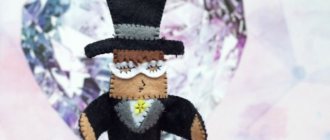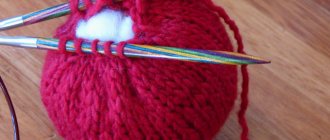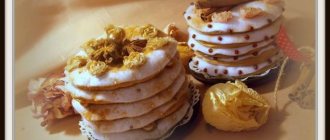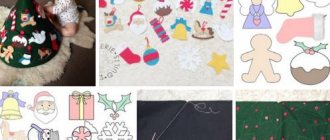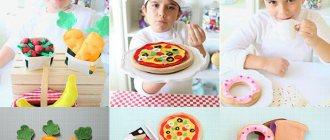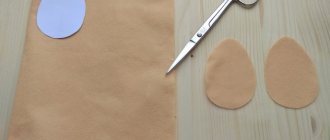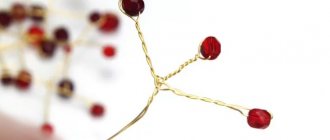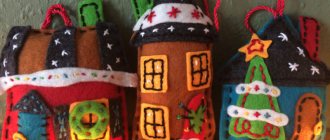- December 1, 2018
- Needlework
- Irina Kotova
A children's book made of felt is a unique toy that develops a child's horizons and also develops fine motor skills. In everyday life, such a thing is called a busy or quiet book, and all because it can interest the baby for a long time. An educational book can be purchased at any children's store, or you can create it yourself to suit your baby's taste. In this article we will tell you how to make a book out of felt.
Necessary materials
To create a book, you can use not only felt fabric, but also any other. One of the main advantages of felt is the lack of edge processing.
The basic list of materials needed to create a book includes:
- Felt fabric. Remember that high-quality felt should not crumble and keep its shape perfectly.
- Cotton fabric. It is often used as a basis for pages.
- Faux leather, faux fur or fleece. These types of fabric are usually used to imitate various surfaces. For example, a tree trunk can be made from brown faux leather.
- Doublerin. Necessary for compacting pages. Thanks to this material, the educational book will not change shape. You should not replace it with cardboard, as the product will not be able to be washed in the future.
- Glue web. Used for fixing various parts.
- Sintepon. It is placed between pages to add volume.
- Velcro fabric. In simple words, this is the soft part of the Velcro to which various parts can be easily attached. This fabric has two varieties: with and without adhesive.
How to work with this fabric when creating educational books is described in the following video:
- Contact tape. With its help, you can attach removable parts to the pages of an educational book.
- Waxed thread, rapeseed tape, as well as laces and hat elastics. You should not use satin ribbons, as Velcro will quickly cause them to lose their appearance.
- Decorative elements. You can use various buttons, beads, beads, rhinestones and much more.
- Threads. Both floss, monofilament, and ordinary sewing threads of various shades are suitable.
- Hooks, buttons, neodymium magnets. They are used to secure removable parts in the book.
This list can be supplemented by any other materials, because each book is unique and you can use whatever you consider necessary to make it.
Required materials and tools
You can create a book yourself. To do this you will need a minimum of materials:
- Felt of different colors and textures;
- Sheets of corrugated cardboard for filling and strengthening pages;
- Tapes for binding pages;
- Velcro and buttons for parts;
- Patterns of small parts;
- Filling for small parts: dry herbs, padding polyester;
- Buttons;
- Threads for bills;
- Tweeters for small parts.
Tools you will need are scissors, needles and threads, a hole punch, a pencil and chalk. It is also necessary to think through the plots of the book and prepare patterns for the details based on them. Most of them are so simple that they can be drawn by hand.
Types of assembling ready-made pages for educational books
Developmental books come in the following types:
- With removable pages. There are two options for assembling a book: using eyelets or buttons.
- Binding with permanent pages. A common option for fabric books.
An interesting option is to assemble the book onto plastic or iron rings. The range of colors is quite large. The main selection criterion is their diameter.
It will look original and beautiful if you attach the pages using ribbons and thread beads on them. Thus, you will get a kind of handle by which the child can carry the book.
How to make a book with your own hands from paper?
A paper book can be glued together, the pages can be sewn together with a needle and thread, or the pages can be stapled together. Most often, standard books are made in the form of a notebook or album, but sheets of fancy, free-form shapes look more interesting.
The book could look like this
If you want to create a baby book of a non-standard shape, then it will be most convenient to make pages using a stencil. Cut out one sheet of thick paper and copy the rest of the sheets from it. Inside the baby book there can be poems, sayings, drawings and applications. Topics for books are sometimes set by the teacher at school, and on free themes it is interesting to write fairy tales and draw illustrations for them yourself.
Children's books on the theme of fairy tales by Alexander Pushkin
Features of creation
The basis for creating a felt book is a single sewing principle:
- We trace the elements on felt, cut them out and sew them onto the page.
- We sew two finished sheets together, hiding the wrong side.
- In order to give a book a special look, you also need to pay attention to the seams. There are several types of them that are used to create educational toys. For removable elements, use the first option shown in the picture. The second method is used for sewing elements. Finally, the buttonhole stitch is used to finish the pages.
- We attach the pages together in any way we like.
- The processed edges with curly scissors will give a beautiful overall look. If you use tarpaulin fabric between two sheets of felt, the leaves will become stiffer, and if padding polyester, then softer.
Tools required for work
To make your own felt book you will need:
- felt of various colors;
- cotton (the basis of the book pages);
- a variety of fabrics to create a story on the pages: fleece, faux leather and fur;
- doublerin (used to seal pages);
Reference! When choosing a material, it is recommended to pay attention to collar dublerin, which is also called bandeau, as it is characterized by increased density
- adhesive web (for fixing various details on the page);
- padding polyester (to give volume to the pages);
- Velcro (for creating removable parts);
- all kinds of ribbons, ropes, laces, beads, buttons, and other accessories;
- eyelets, buttons, rings (for creating removable pages);
- binding (for processing the edges of each page);
- threads;
- a set of needles;
- scissors;
- glue;
- pattern.
Attention! Since felt is the main material for making a book, you should approach the choice of this material especially responsibly. Experienced craftswomen advise using hard Korean felt
It holds its shape well, the edges do not crumble, and the product retains its original appearance for a long time.
Step-by-step guide to creating a book
To make a developmental book, you need:
- Decide on the topic of the book. It is important that it corresponds to the age of the child.
- Choose templates for educational books made from felt.
- Select the page size of the future product. The standard size is 20*20 cm. For the smallest ones, pages measuring 15*15 cm can be made.
- Prepare the pages. For convenience, you can make a template from cardboard in the following sizes: 20*20 and 19.5*19.5 cm. Next, we place the 20*20 cm blank on felt fabric and cut it out according to the template. We cut out a 19.5*19.5 square from dublerin.
- Then apply the dublerin with the adhesive side to the felt fabric and iron it with an iron. If the dublerin is not dense enough, the page can be made of two layers.
- Proceed to the design of the pages and cover: we create appliqués from felt in accordance with your idea.
- If you decide to make a book with permanent pages, then at this stage we sew the sheets together so that the wrong side is hidden, and then we attach various accessories and ribbons.
The process of sewing a permanent cover is approximately the same. The only difference is that for the spine you need to leave a small piece of felt, the size of which depends on the thickness of the sheets. It is worth considering that the cover of the book should be much denser than the pages.
How to make a felt baby book
The preparatory part is the same as described above. Only less materials are used - no seals or cushioning fabrics are needed. The dimensions should be small - 15-22 cm.
- Making a diaper cake with your own hands: a step-by-step master class on how to fold a gift for newborns (100 photos)
DIY crafts from egg trays: original toy ideas for children and useful crafts for adults (115 photos)
- How does an air source heat pump work?
Any felt will be useful:
- for pages and covers you need felt, with a thickness of 2 to 2.5 (3) mm;
- for plot design, additional elements - of different thicknesses - from 1 mm to the thickest.
Cut the required number of “sheets” from thick felt using sharp scissors or a special circular knife. It is necessary to check the angles to avoid distortions. It is convenient to use special mats with markings. You can make a template of the desired size from thick cardboard or plastic.
Design each page according to a sketch. It is better to sew parts with a straight stitch or decorative seams. Since the pages are not duplicated, you need to make sure that both sides of the sheet look neat - no extra lines or knots.
Game and developmental elements are fixed in a special way:
- Under eyelets, buttons, snaps, hooks, beads, be sure to place a reinforcing piece made of the same felt or from a piece of adhesive dublerin (thick non-woven fabric). So that these “patches” do not catch the eye, they can be painted over with a fabric marker.
- It is better to “melt” the nodules. On the second side of the sheet these places must be “hidden”;
- It is easier to sew “zippers” to felt than to fabric, so they are used a lot. Children love this element;
- The required felt color is not always available. Then, using a glue “web”, prepare the fabric parts, glue them to the page and stitch them;
- Before making “constrictions”, as well as other similar elements, you need to think carefully about their fastening. In such books (when the pages are felt) they are rarely used.
- Velcro fabric is processed and glued in the usual way.
Small additional game details are made using different techniques:
- finger toys are sewn from thin and medium-thick felt. The faces of dolls, the faces of animals, and other “little things” are embroidered or painted with acrylic paints or felt-tip pens on fabric.
- One-sided parts are made from thick material.
- using fillers you can get voluminous toys;
- If you order a print of characters, the alphabet, numbers, or other necessary drawings, then they are simply cut out along the contour - you get ready-made parts.
- DIY birch bark crafts - techniques and master class for making crafts for beginners (105 photos)
- What can be made from a construction set - methods of application and examples of what things can be created from children's construction sets (135 photos)
Crafts from baby food jars - 125 photos of original ideas for using small jars
Check the sheets for size. The edges are often processed with curly zizag and wave scissors.
Depending on the method of assembling the book, make a cover and clasp.
Tip: the cover and binding are done last, because it is difficult to predict the thickness of the finished book.
In books whose pages are made of felt, different assembly options are used:
- "blind" binding;
- methods when sheets are removed from binding;
- on rings - here you don’t have to do the binding.
Animal patterns
You can introduce your child to domestic and wild animals with the help of an educational book. The cat can catch fish, and the dog can put bones in the doghouse, which can later be counted. There can be as many options as you like, it all depends on your imagination. We offer you a selection of simple and original templates for educational felt books.
A bright tiger cub will definitely delight your baby; to make it you will need two colors of felt fabric:
The following template will help you create a cute baby elephant:
To create a fawn, use the following pattern:
A popular idea for an educational book is a farm where you can collect various domestic animals, including a cow:
Animals from original material
This collection of soft crafts is interesting because it features real fairy-tale heroes and friends of children. And it was created taking into account the sympathies of our little ones. Here you will find all those that the child himself will gladly want to create.
Hedgehog. A real children's favorite is a felt hedgehog. The kids are used to seeing him as a wise cartoon character. They will happily get to work creating a hedgehog.
Owl. Kids will definitely like this adorable felt owl. Moreover, when offering a felt owl pattern, we completely leave the color of this night bird up to you. Everyone is used to her dull feathers. What if your felt owl was bright, pink or multicolored?
Owl patterns:
Butterfly. Here is a wonderful miracle - a butterfly made of felt. Light and colorful. And this is exactly what this excellent material allows you to create.
Dog. By creating crafts with your children, you can teach your little one several things at once:
- love independently and create in company;
- good taste is instilled;
- the baby will always be able to create an original gift;
- and also, he can make himself a friend with his own hands.
Pattern of this dog:
And it is a felt dog that is the most common work of toddlers. After all, she can be made both cheerful and serious, playful and protective. And how many breeds! And how many sizes and colors!
Bear. In Raschudesye, you can choose from a full assortment of both a white resident of the land of eternal people and a local, our fellow countryman. All these models can be designed independently, in the form of activities with the baby.
Bear pattern:
Dolls. Do-it-yourself felt dolls are not just a return to the traditions of their people, when such products were exclusively the work of the parents, and then the little one himself. This is also the desire to give your baby the best. Create a dream for him.
All the wishes of a child can be easily realized in the craft of making dolls. You shouldn’t follow conservative, boring views when you can make such a funny and bright doll that our little one will definitely like and delight him!
Felt fairy tale book templates
Fairy tales not only captivate the baby, but also contribute to rapid development. It won’t be difficult to please your child with such a product.
To make it you will need:
- multi-colored felt;
- scissors;
- threads with a needle;
- patterns of elements.
Work stage:
- We draw on paper the characters necessary for the fairy tale or use ready-made templates for an educational felt book.
- We trace the finished parts on felt fabric and cut them out.
- We sew together the parts of the characters.
- The edge of the book can be processed on a sewing machine by selecting the “zigzag” function
Do-it-yourself educational book for little ones made from felt: step-by-step instructions
To make it easier to sew a book, make sketches on paper for the most difficult pages to sew. Draw animal figures, flowers, geometric shapes. You can use ready-made templates for these purposes. After the idea is thought up and a sketch is made, it’s time to start sewing the pages.
Templates for a soft book
Each page of the book consists of fabric, which will be the face of the page, and adhesive fabric of the same size.
- Iron on the sealing adhesive fabric to the face fabric
- Cut out figures for applique and small parts for figures from felt.
- Hand-assemble figurines of animals, flowers, numbers and letters
- Machine sew all the details
- Pin the finished appliqués to the fabric or attach them with a few stitches by hand using a needle.
- Using a zigzag or straight stitch, sew the shapes onto the page.
Video: How to sew felt blanks to a page?
The pages of a book where animals seem to be sitting in the grass, flowers or trees look interesting.
Ideas for applique figures
How to make Velcro appliques?
You can sew Velcro directly onto the felt from the wrong side. But, if you have doubts that during the process of tearing off and gluing the figure with Velcro will not tear, then you can lay a sealing fabric under the felt. Sew a square of Velcro onto a thick fabric larger than the applique.
Velcro leaves
- Place the sealing fabric on the back of the applique in the center
- Pin and zigzag sew the applique to the backing fabric.
- Then carefully trim the protruding edge of the fabric with scissors.
- Sew all the pieces together
If the applique is small, then the Velcro can be sewn not in the center, but along the contour of the part. You can learn in detail how to do this by watching the video. The second soft side of the Velcro is sewn directly to the book page.
Video: How to sew Velcro to the details of a developmental book?
After all the appliqués, buttons, laces and other details are sewn on, you can begin sewing the pages and assembling the book. Take the fabric with sewn appliqués, lay it face down on the table, place the padding polyester on top and the second part of the page face up.
Now you can sew the page manually along the edge, and then trim off the protruding edges of the padding polyester. The edge of the page is trimmed with trim as shown in the following video.
Video: How to sew a page from an educational soft book?
To assemble the pages of a book into a binding, a strip of fabric is attached to them. The line goes from the inside out, so when you turn the book you can see a neat transition from one page to another. The stages of working with binding can be seen more clearly in the video below.
Video: how to stitch the binding of a soft book?
When the pages are sewn on, all that remains is to beautifully close the binding with a piece of fabric. It is sewn by hand and then sewn to the book with one line. How to do this is described in detail in the fourth video.
Video: How to beautifully close the binding of a soft book?
Basic recommendations on how to make elements for a felt book using a template
It's simple. Making an educational book out of felt is considered not a difficult task. But to make them you also need to be smart. The following steps will help you navigate the pattern:
- After we have chosen the necessary templates, we prepare the fabric, filler, threads and scissors.
- Print the pattern on paper and cut it out. We apply it to the fabric, trace it and use scissors to create the desired shape.
- If necessary, we glue the necessary elements for the product onto the finished workpiece. For example, the face of an animal can be embroidered with threads, decorated with buttons or beads.
- You can fill the elements of the book with holofiber, padding polyester or medical cotton wool.
How to design educational pages from felt
There are a lot of options for designing development pages. For example, start by studying the numbers. There are also a lot of different ideas here.
You can combine numbers and further teaching of time.
Invite your child to pull the ducks out of their testicles and count how many of them are floating in the pond.
You can make small scores on the pages. Opposite each number you should attach a thread along which wooden or plastic elements move.
There is also an option for teaching numbers using buttons. They need to be sewn onto small felt pieces next to the number being studied. The parts can be made with Velcro so that the child can independently attach them to the right places.
To study numbers, you can use a book with a train, in each carriage of which there is a certain number, and inside are various vegetables.
Every child should know geometric shapes. To study them, you can also make educational pages from felt. The main elements are circle, square, triangle, rectangle, oval, asterisk, heart.
You can come up with a book with felt figures, similar to a construction set, only with Velcro.
Here geometric elements are depicted on the hedgehog's balls.
The figures can be transported by a train.
Invite your child to study who eats what.
For older children, a book that teaches the rules of the road, when and in what places to cross the road, is suitable.
Felt puzzles with Velcro will help develop hand motor skills and thinking.
In a book with elements like Tetris, the child must put the figures together so that they all fit.
In the version with cars, the child must choose the right wheel according to the color of the car.
Various Velcro page ideas are suitable for developing fine motor skills.
Here, growing vegetables in the beds will be an interesting activity.
Apples can be collected in a bucket, and vegetables can be laid out in beds.
It will be interesting for the child to tell the tale about the tower himself. The next page of the book can be decorated with felt figures on the theme of fishing.
Kids will definitely like pages with animals.
Options using trees can be very diverse.
You should definitely include a page with zippers in the learning book so that your baby learns how to unfasten and fasten them.
Invite the children to brush the hippopotamus’s teeth, and for their uncle to try on a new hairstyle or mustache.
A little mouse lives in a mushroom.
A pot of flowers will help in learning about flowers and developing fine motor skills. In addition, this will teach your baby how to fasten buttons.
Girls will have fun playing laundry. To do this, you can make a page with a washing machine, cabinets and clothespins.
Bathing and putting little cats to bed will be a wonderful bedtime ritual for your baby.
To study the seasons, you can sew four trees from felt.
Invite your child to find a couple of pictures.
If you don’t have time to make a large and thick book, there are more compact educational options.
Educational toys will help your baby acquire basic knowledge about the world. You can sew a bright and colorful felt book yourself by choosing a suitable design idea.
A sea of ideas
Don't know where to start? A variety of patterns will prompt creative ideas.
Related article: Rating of the most effective bath cleaners


